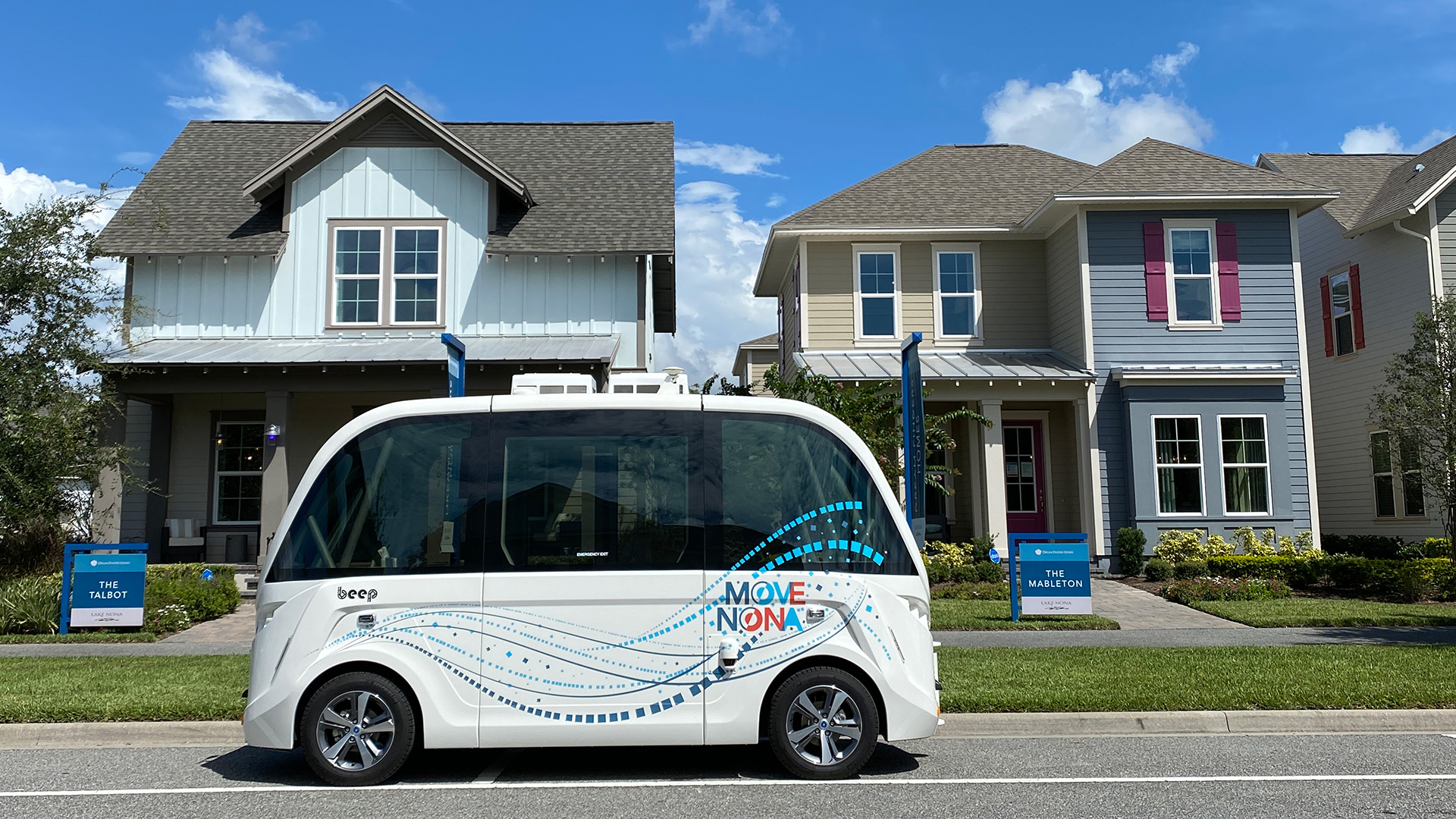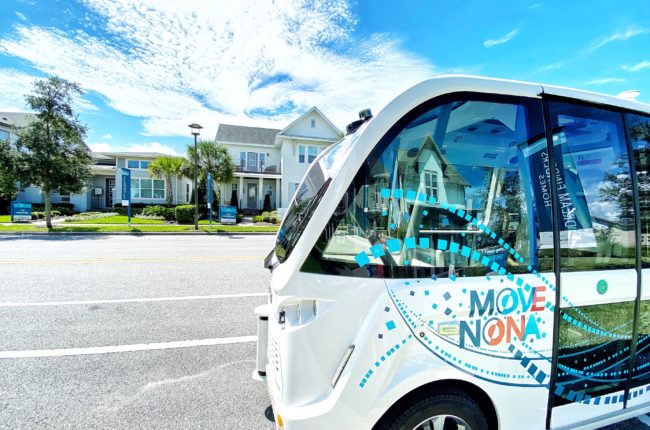May 4, 2022
Over the past two and a half years, residents of Lake Nona, a planned community in Orlando, Florida, have been living in the future. The Lake Nona project saw us partnering with the Tavistock Development Company (the development firm behind Lake Nona) and automated vehicle operator Beep to develop the federal BUILD grant proposal for what would eventually become an automated, electric shuttle system.
When we last wrote about the project in early 2020, Lake Nona had eight shuttles servicing four routes. Today, the circulator has expanded its service to five routes (with more in consideration), and, according to Beep, has offered more than 40,000 rides to the residents and visitors of Lake Nona. Though Tavistock and Beep cover the cost of operating the circulator, meaning the rides themselves are free of charge, the experience is generating other benefits to Beep and its customers. The Lake Nona shuttle fleet offered many of these riders their first exposure to automated vehicles (AVs), and has given the industry nearly three years’ of data on how automated vehicles navigate real-world traffic.

The Lake Nona shuttle fleet offered many of these riders their first exposure to automated vehicles (AVs), and has given the industry nearly three years' of data on how automated vehicles navigate real-world traffic. Image Credit: Beep
The Move Toward Automated Transportation
Transportation has been driving toward a driverless future for decades. Since 2004, the Defense Advanced Research Projects Agency (DARPA) challenges have tested innovation through a variety of autonomous vehicle competitions. In 2016, the U.S. Department of Transportation launched its Smart City Challenge, which tasked cities across the country with designing “first-of-its-kind smart transportation systems that would use data, applications, and technology to help people and goods move more quickly, cheaply, and efficiently.” Columbus, Ohio eventually won the $50 million prize. Despite the DARPA and Smart City Challenges, there has been a widespread lack of funding available to study how automated transportation works in real-world communities.
Though driverless technologies have been tested multiple controlled environments (including University of Michigan’s Mcity, which launched in 2015) most AV deployments been for demonstration purposes and have lasted no longer than a month in the real world, and sometimes for only a single day. (As part of its Smart City initiative, Columbus has accomplished two of the longer AV implementations, including a ten-month circulator service that ran until September 2019, and a ten-month food pantry-delivery pilot that ran until April 2021.)
From its onset, Lake Nona project presented a rare exercise in transportation planning, as well as an opportunity to collect data and learn. Unlike the short-term demonstrations, Lake Nona’s eight-shuttle fleet has been in circulation since 2019, producing an unprecedented body of data. This data is giving engineers and planners a more nuanced understanding of what questions to address if these technologies are to eventually form the backbone of American urban transportation infrastructure like what assistance to riders need to access the automated shuttles, or what road designs or traffic scenarios present challenges for automated driving systems.
Laying the Groundwork for Smart Cities
In the planning phase of this project, the fundamentals of transit planning came face to face with questions posed by emerging technologies. The intellectual challenge (and pleasure) of this phase resided in these intersections, and in discovering how the foundations of transportation thought could be used to predict and troubleshoot the constraints of emerging technologies.
Certain technology constraints required avoidance in planning:
- routes were initially planned to minimize potential conflicts between the automated vehicles and vulnerable road users, such as children in school zones;
- routes were shaped to avoid left turns and high-speed traffic whenever possible;
- and finally, routes had to be planned with the range of the electric battery in mind.
Meanwhile, other constraints resulted in recommendations that were additive in nature:
- we worked with Beep to implement a dedicated lane for shuttles, minimizing speed conflicts with other vehicles;
- we also provided input on the design of an overpass to allow the fleet to avoid Lake Nona Boulevard, a major traffic artery in the area.
As automated vehicle technology continues to evolve, planners may find they can navigate some of these considerations with greater ease. (Battery life in the shuttles may improve, for example.) Nevertheless, the Lake Nona project demonstrates not only that it’s possible to begin adapting existing city infrastructure to new technology, but that such incremental adaptations are part of the growth process; that doing so actually yields wisdom that will guide and shape that technology’s maturation.
Lessons from Lake Nona
Beyond the challenges and rewards inherent to planning an automated, electric transit system, several unique aspects of the Lake Nona project make it a valuable pilot program and an information-rich test case.
Going forward, successful implementations will require a thorough understanding of how AV mapping technologies interact with the real world. Different system developers rely on different mapping software systems in their products, which in turn changes how their products interpret incoming information and make navigational decisions. The mapping technology will need to be able to contend with the transit system’s natural environment, which may be variable or highly mutable. The LiDAR (Light Detection and Ranging) mapping technology on Beep shuttles, for instance, had to contend with the fast-growing Floridian vegetation, which occasionally created unexpected obstacles on routes. As planners use the Lake Nona pilot program as a model for larger and more comprehensive urban infrastructure reforms, anticipating these details as well as their complications will prove crucial to scaling successfully.
The Future of the Future: What’s Next in Automation
 While the immediate benefits of Lake Nona’s automated fleet would be cause enough for celebration-the service facilitates easy transport and reduces car use throughout Lake Nona, shrinking the community’s carbon footprint-the deeper victory in Lake Nona’s success rests in the way the project heralds a larger paradigm shift for the transportation profession. The Lake Nona project embodies a new precedent in transit planning, as the focus increasingly turns to automated and interconnected city infrastructure.
While the immediate benefits of Lake Nona’s automated fleet would be cause enough for celebration-the service facilitates easy transport and reduces car use throughout Lake Nona, shrinking the community’s carbon footprint-the deeper victory in Lake Nona’s success rests in the way the project heralds a larger paradigm shift for the transportation profession. The Lake Nona project embodies a new precedent in transit planning, as the focus increasingly turns to automated and interconnected city infrastructure.
Other pilot programs like the one at Lake Nona are cropping up all over the country. In January 2022, Beep, in collaboration with the City of Peoria, Arizona, The University of Arizona, and the Maricopa Association of Governments, launched RoboRide Medical, an automated, electric shuttle system to improve resident access to healthcare. Kittelson has recently been working with the Florida Department of Transportation to analyze existing infrastructure throughout southwest Florida to identify the optimal route for an automated circulator shuttle. We are also consulting with the North Central Texas Council of Governments (NCTCOG), the regional planning community for the Dallas-Fort Worth area, on their initiative to provide guidance to local agencies on how to rethink the planning process to better accommodate automated transportation technologies. The NCTCOG serves more than 230 government bodies throughout the metroplex: in this massive, diverse environment, the lessons from the Lake Nona project will find a larger stage, and with it, a larger audience to reach.
Here at Kittelson, we’re always looking forward. Feel free to reach out to Associate Engineer Abby Morgan or Principal Planner Gibran Hadj-Chikh to hear more about upcoming projects in automated transit.
